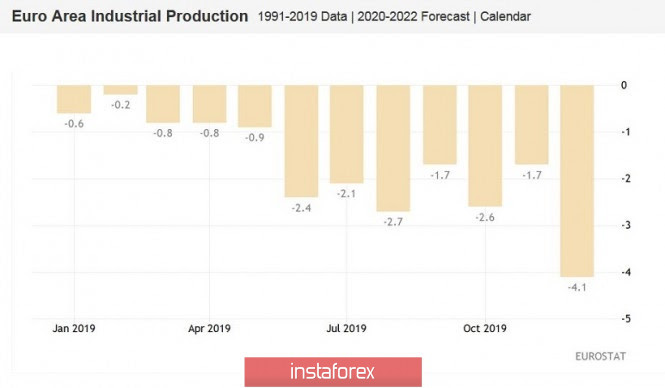The EUR/USD bears again storm the eighth figure, returning to the lows of last year. Judging by the dynamics of decline, sellers will nevertheless overcome the low of 1.0879 and head towards the lower line of the Bollinger Bands indicator on the monthly chart (mark 1.0810). This state of affairs reflects the strength of the US economy - the greenback is in demand both in periods of a surge in anti-risk sentiment and in calmer periods. On the other hand, further revaluation of the dollar will soon turn against the US economy, slowing inflationary growth and negatively affecting the export sector. At the end of 2016 and at the beginning of 2017, the EUR/USD pair sank to the third figure, and the probability of parity was seriously discussed in the market. But then the expensive dollar "hit on" the Federal Reserve with a slowdown in inflation and other related side effects.

Now it's too early to talk about parity, but at the same time, the dollar is actively demolishing many of the barriers that previously held back the sellers of the pair. For example, since the fall of last year, the bears have made countless attempts to gain a foothold below the 10th figure. Even if they plunged under the 1.1000 mark, the pair attracted buyers at these levels, after which the price continued to be suspended between 10 and 12 figures.
To date, the situation is somewhat different. It is quite difficult for the pair's bulls to return lost points even during periods of rare corrections, while the dollar receives support both from macroeconomic statistics and from the Fed, which continues to hold a wait-and-see position. In turn, the European currency is under large-scale pressure from all sides: inflation in the eurozone has slowed, Christine Lagarde voices pessimistic forecasts, and Brexit did not bring the long-awaited relief.
All this suggests that the dollar will continue to dominate in the near future, if only January inflation does not alarm dollar bulls (the release is scheduled for tomorrow, February 13). It is noteworthy that the US currency calmly reacted to the Fed report, where regulator members expressed concern about the spread of the Chinese coronavirus. Speaking in Congress, Jerome Powell, on the one hand, focused his attention on this issue. But at the same time, he noted that it is too early to talk about any negative impact on the US economy. In addition, today it became known that the deadly virus has slowed the pace of "planet conquest." Despite the fact that the number of dead and sick has increased, the pace of infection has slowed. But the number of recovered has increased - up to 4740 people (that is, 745 people per day). China also reported the lowest daily number of new cases of coronavirus since late January. Although such news cannot be called encouraging, the foreign exchange market reacted positively to them.
The dollar was not afraid of the political factor either. Although all the preconditions for the greenback reduction were: yesterday, former US Vice President Joe Biden, who was considered the favorite of the presidential race from the Democratic Party, lost the second primaries. But Senator Bernie Sanders, who calls himself a "democratic socialist," unexpectedly took the lead in the election race among the Democrats. Young people voted for him, as well as representatives of the African American and Spanish communities in the United States. According to experts, he currently wins with a score of 48% versus 42% in the competition with Trump.

Sanders has a reputation for being almost a "communist," as he offers US society to introduce the principles of free medicine, free college education, a program of guaranteed jobs and write-offs of student debts. He also advocates for narrowing the wage gap between top managers and employees. According to some experts, if Sanders wins (and this option can no longer be ruled out), the budget deficit will increase in many ways, and "the printing press will work without stopping." Naturally, such prospects, albeit still hypothetical in nature, could exert background pressure on the US currency.
But the market has so far calmly reacted to such trends. Apparently, traders do not yet believe that a "democratic socialist" will be able to remove the Republican president (although Trump's victory also seemed extremely unlikely at the time). And Trump's rating significantly increased after his impeachment in the Senate failed miserably. According to a survey by the University of Monmouth, most US citizens are confident that the president will achieve re-election. According to the study, 66% of U.S. voters predict Trump's victory in the November elections, and only 28% believe he will lose. Therefore, dollar bulls so far ignore Sanders' breakthrough, although, in my opinion, this is a time bomb.
It is also worth noting that the European currency is too weak to compete for leadership in tandem with the dollar. Today it became known that the volume of industrial production in the eurozone countries fell to -2.1% on a monthly basis and to -4.1% on an annualized basis. Both indicators came out in the red zone, not significantly reaching the forecast values. Such dynamics put additional pressure on the euro, which is still knocked down after the slowdown in inflation growth and soft comments of ECB members.

Thus, the EUR/USD bears have every chance to update the low of the current and previous year. Sellers of the pair may come to the middle of the eighth figure tomorrow, especially if US inflation will surprise investors with significant growth.
The material has been provided by InstaForex Company - www.instaforex.com